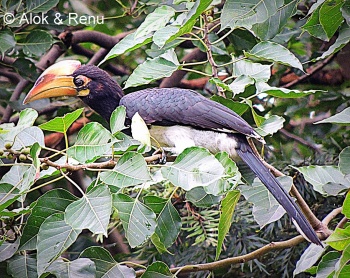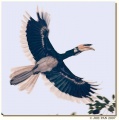Alternative names: Asian Pied Hornbill; Northern Pied Hornbill; Malaysian Pied Hornbill
Includes: Sunda Pied Hornbill
- Anthracoceros albirostris
Identification
75 cm. Large black and white hornbill
- casque large, yellow-white
- patch under the eye white
- lower belly, thighs, and undertail coverts white
- tips to flight feathers white
- outer tail feathers white
- Iris dark brown
- naked skin around eye and gular skin white
- bill and casque yellow-white. Black marks on base of lower mandible and front of casque (latter large, angled obliquely and may extend to upper mandible)
- feet black
Similar species

Photo by Alok Tewari
Rishikesh, Uttarakhand Himalayas, India, August-2015
Smaller than Malabar Pied Hornbill, less black on casque and pale blue (not pink-tinged) throat skin.
Distribution
From northern India and Nepal east to southern China, Burma, south to Thailand, Indochina, Malay Peninsula, Sumatra, Borneo, Java and Bali.
The commonest Asian Hornbill.
Taxonomy
Forms a superspecies with Malabar Pied Hornbill and Palawan Hornbill. Was long considered to be conspecific with Malabar Pied Hornbill and the two species have been confused several times, leading to synonymy of common and scientific names.
Subspecies convexus may be elevated as "Sunda Pied Hornbill", A. convexus.
Subspecies

Photo by Alok Tewari
Rishikesh, Uttarakhand Himalayas, India, August-2013
Clements recognises the following subspecies [1]:
- A. a. albirostris: northern India and southern Nepal east to China (Yunnan, Guangxi) and south to Burma, Thailand, Vietnam, Laos, Cambodia and northern peninsular Malaysia
- A. a. convexus: "Sunda Pied Hornbill". southern peninsular Malaysia to Sumatra, Borneo, Java, Bali and many adjacent smaller islands
Habitat
Open habitat such as forest edge, clearings and secondary forest. Occurs up to 700m.
Behaviour
Diet
Feeds mainly on fruit, takes also small animals.
Breeding
Breeds in pairs. Nests in a natural cavity in a tree. The incubating females are sealed into tree hole nests with mud, leaving only a small aperture through which food can be passed by the male. When the young are hatched the female breaks out but reseals the nest entrance again until the young are ready to leave.
Gallery
Click on photo for larger image
Note nest hole (female inside)
Photo by the late Laurence Poh
Kampung Gajah, Malaysia, December 2003
References
- Clements, J. F., T. S. Schulenberg, M. J. Iliff, D. Roberson, T. A. Fredericks, B. L. Sullivan, and C. L. Wood. 2017. The eBird/Clements checklist of birds of the world: v2017, with updates to August 2017. Downloaded from http://www.birds.cornell.edu/clementschecklist/download/
- Del Hoyo, J, A Elliot, and J Sargatal, eds. 2001. Handbook of the Birds of the World. Volume 6: Mousebirds to Hornbills. Barcelona: Lynx Edicions. ISBN 978-8487334306
Recommended Citation
- BirdForum Opus contributors. (2025) Oriental Pied Hornbill. In: BirdForum, the forum for wild birds and birding. Retrieved 26 April 2025 from https://www.birdforum.net/opus/Oriental_Pied_Hornbill
External Links
GSearch checked for 2020 platform.1






